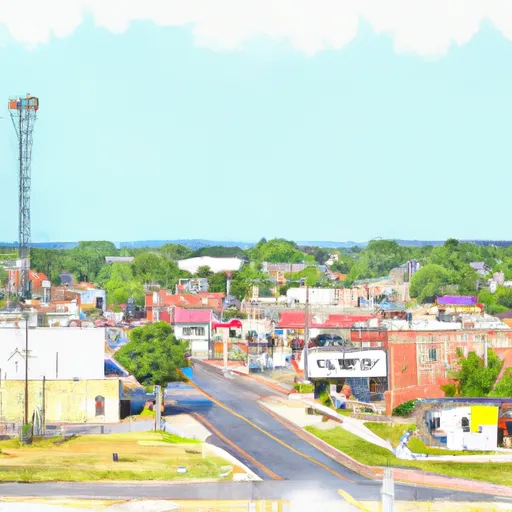-
 Snoflo Premium
Snoflo Premium
Get unlimited access to all our content
With no Ad interruptions! - Start Your Free Trial Login with existing account
Langston
Eden Index
Climate
8.3
•
Recreation
2.8
•
Community
1.4
•
Safeguard
4.6/10

Langston, Oklahoma is a small town located in Logan County in central Oklahoma. The climate in Langston is characterized by hot summers and mild winters. Summers are typically hot and humid, with average temperatures ranging from the mid-80s to the mid-90s Fahrenheit. Winters are generally mild, with average temperatures hovering around the 40s and occasional light snowfall.
As for hydrology constituents, Langston benefits from the presence of the Cimarron River, which flows nearby. The river serves as a valuable water source and contributes to the area's natural beauty. Additionally, Langston is situated in an area known for its fertile soil, making agriculture a significant part of the local economy.
Outdoor recreation opportunities abound in and around Langston. The Cimarron River offers opportunities for fishing, canoeing, and kayaking. The surrounding countryside provides ample space for hiking, camping, and picnicking. Nearby natural areas, such as the Gloss Mountain State Park, give visitors the chance to explore unique geological formations and enjoy breathtaking views. Langston is also home to Langston University, which boasts various recreational facilities, including sports fields, fitness centers, and a golf course, providing additional opportunities for outdoor activities and sports enthusiasts.
What is the Eden Index?
The Snoflo Eden Index serves as a comprehensive rating system for regions, evaluating their desirability through a holistic assessment of climate health, outdoor recreation opportunities, and natural disaster risk, acknowledging the profound impact of these factors on livability and well-being.
Climate Health Indicator (CHI): 8.3
Langston receives approximately
914mm of rain per year,
with humidity levels near 81%
and air temperatures averaging around
16°C.
Langston has a plant hardyness factor of
7, meaning
plants and agriculture in this region tend to thrive during the non-winter months.
By considering the ideal temperature range, reliable water supplies, clean air, and stable seasonal rain or snowpacks, the Climate Health Indicator (CHI) underscores the significance of a healthy climate as the foundation for quality living.
A healthy climate is paramount for ensuring a high quality of life and livability in a region, fostering both physical well-being and environmental harmony. This can be characterized by ideal temperatures, reliable access to water supplies, clean air, and consistent seasonal rain or snowpacks.
Weather Forecast
Streamflow Conditions
Lower Cimarron
Area Rivers
Lower Cimarron
Snowpack Depths
Lower Cimarron
Reservoir Storage Capacity
Lower Cimarron
Groundwater Levels
Recreational Opportunity Index (ROI): 2.8
The Recreational Opportunity Index (ROI) recognizes the value of outdoor recreational options, such as parks, hiking trails, camping sites, and fishing spots, while acknowledging that climate plays a pivotal role in ensuring the comfort and consistency of these experiences.
Access to outdoor recreational opportunities, encompassing activities such as parks, hiking, camping, and fishing, is crucial for overall well-being, and the climate plays a pivotal role in enabling and enhancing these experiences, ensuring that individuals can engage in nature-based activities comfortably and consistently.
Camping Areas
| Campground | Campsites | Reservations | Toilets | Showers | Elevation |
|---|---|---|---|---|---|
| Healdton Municipal Lake | 57 | 900 ft | |||
| Lake Thunderbird State Park - North | None | 1,081 ft | |||
| Turner Falls Park | 500 | 960 ft | |||
| Shawnee Twin Lakes | None | 1,101 ft | |||
| Lake Thunderbird State Park - South | None | 1,146 ft | |||
| Guy Sandy - Chickasaw National Rec Area | None | 1,015 ft | |||
| R.C. Longmire Lake | None | 1,002 ft | |||
| Mountain Lake | None | 1,002 ft | |||
| Chandler City Park - Purcell | 25 | 1,091 ft | |||
| Pauls Valley City Lake | 28 | 910 ft |
Catastrophe Safeguard Index (CSI):
The Catastrophe Safeguard Index (CSI) recognizes that natural disaster risk, encompassing floods, fires, hurricanes, and tornadoes, can drastically affect safety and the overall appeal of an area.
The level of natural disaster risk in a region significantly affects safety and the overall livability, with climate change amplifying these risks by potentially increasing the frequency and intensity of events like floods, fires, hurricanes, and tornadoes, thereby posing substantial challenges to community resilience and well-being.
Community Resilience Indicator (CRI): 1.4
The Community Resilience Indicator (CRI) recognizes that education, healthcare, and socioeconomics are crucial to the well-being of a region. The CRI acknowledges the profound impact of these elements on residents' overall quality of life. By evaluating educational resources, healthcare accessibility, and economic inclusivity, the index captures the essential aspects that contribute to a thriving community, fostering resident satisfaction, equity, and social cohesion.

